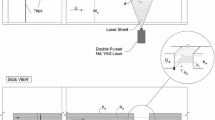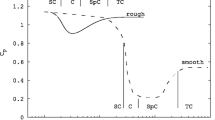Abstract
Shallow wakes that occur in a wide range of natural flows tend to generate instabilities that develop into large, 2D coherent structures (2DCS). We present the results of an experimental study to stabilize shallow wakes by local, enhanced bottom roughness. Two successful stabilization strategies are compared to a base case of an unsteady bubble wake. First, localized bed roughness is placed in the lateral shear layers near the shoulders of the cylinder. Second, a local roughness element is placed at the end of the recirculation bubble, in the downstream region where large-scale vortices would normally shed. Dye visualization is used to assess the qualitative behavior of the wake, and two-component laser Doppler velocimetry (LDV) measurements are made to measure the Reynolds stress distributions and time-averaged velocity profiles. In both stabilization cases, a minimum patch size of the enhanced roughness elements is required for stabilization, which depends on the momentum thickness of the shear layers and the locations of enhanced Reynolds shear stresses. The main effect of the wake stabilization is a reduction in momentum exchange with the ambient flow due to damping of the large 2DCS. This reduction in eddy diffusivity results in a narrower wake and a slower decay of the centerline velocity deficit with downstream distance compared to the base case of an unsteady bubble wake.











Similar content being viewed by others
References
Anagnostopoulos P (1997) Computer-aided flow visualization and vorticity balance in the laminar wake of a circular cylinder. J Fluid Struct 11:33–72
Balachandar S, Mittal R, Najjar FM (1997) Properties of the mean recirculation region in the wakes of two-dimensional bluff bodies. J Fluid Mech 351:167–199
Bearman P (1967) Investigation of the flow behind a two-dimensional model with blunt trailing edge and fitted with splitter plates. J Fluid Mech 21:241–255
Carmer CF, Koch T, Jirka GH (2000) Großräumige Wirbelstrukturen in turbulenter Flachwasserströmung. Bericht 766, Inst für Hydromech, Universität Karlsruhe, Karlsruhe, Germany
Chen D, Jirka GH (1995) Experimental study of plane turbulent wakes in a shallow water layer. Fluid Dyn Res 16:11–41
Chen D, Jirka GH (1997) Absolute and convective instabilities of plane turbulent wakes in shallow water layer. J Fluid Mech 338:157–172
Chu V, Wu J, Khayat R (1991) Stability of transverse shear flows in shallow open channels. J Hydraul Eng 117(10):1370–1389
Gerich D, Eckelmann H (1982) Influence of end plates and free ends on the shedding frequency of circular cylinders. J Fluid Mech 122:109–121
Gerrard JH (1978) The wake of cylinder bluff bodies at low Reynolds number. Philos Trans R Soc Lond 288:351–382
Grubisic V, Smith RB, Schar C (1995) The effect of bottom friction on shallow-water flow past an isolated obstacle. J Atmos Sci 48:1985
Ingram RG, Chu VH (1987) Flow around islands in Rupert Bay: an investigation of the bottom friction effect. J Geophys Res 92:14521
Jirka GH (2001) Large scale flow structures and mixing processes in shallow flows. J Hydraul Res 39(6):567–573
Kahraman A, Sahin B, Rockwell D (2002) Control of vortex formation from a vertical cylinder in shallow water: effect of localized roughness. Exp Fluids 33:54–65
Kim W, Sung J, Yoo JY, Lee MH (2004) High-definition PIV analysis on vortex shedding in the cylinder wake. J Visualization 7(1):17–24
Kruiswyk R, Dutton J (1990) Effects of a base cavity on a subsonic near-wake flow. AIAA J 28(11):1885–1893
Morkovin MV (1964) Flow around circular cylinder—kaleidoscope of challenging fluid phenomena. In: Proceedings of the ASME symposium on fully separated flows, vol 1, p 102
Negretti M (2002) Entwicklung 2D kohärenter Wirbelstrukturen im Nachlauf eines Kreiszylinders in turbulenter Flachwasserströmung. Diploma thesis, Inst fur Hydromech, Universität Karlsruhe, Karlsruhe, Germany
Pattiaratchi C, James A, Collins M (1986) Islands wakes and headland eddies: a comparison between remotely sensed data and laboratory experiments. J Geophys Res 92:783
van Prooijen BC, Uijttewaal W (2002) A linear approach for the evolution of coherent structures in shallow mixing layers. Phys Fluids 14(12):4105–4114
Rockwell D, Chyu CK (2003) Near wake structure of an oscillating cylinder: effect of controlled shear layer vortices. J Fluid Mech 3:119–128
Rockwell D, Fu H, Lin J-C, Ozgoren M (2004) Vortex formation in shallow flows. In: Proceedings of the international symposium on shallow flows, Delft, The Netherlands, 16–18 June 2003, AA Balkema Publishers, Delft, The Netherlands, pp 47–55
Roshko A (1961) Experiments on the flow past a circular cylinder at high Reynolds number. J Fluid Mech 60:345
Rummel A, Carmer CF, Jirka GH (2002) Combined planar measurements of flow velocity and mass concentration in shallow turbulent flow. Part 1: development of a planar concentration analysis (PCA) system. In: Proceedings of the EWRI and IAHR joint conference, Estes Park, Colorado, July/August 2002
Socolofsky SA, Jirka GH (2004) Large-scale flow structures and stability in shallow flows. J Environ Eng Sci 3:451–462
Socolofsky SA, von Carmer C, Jirka GH (2004) Shallow turbulent wakes: linear stability analysis compared to experimental data. In: Proceedings of the international symposium on shallow flows, Delft, The Netherlands, 16–18 June 2003, AA Balkema Publishers, Delft, The Netherlands, pp 31–38
Strykowski PJ, Sreenivasan KR (1990) On the formation and suppression of vortex shedding at low Reynolds numbers. J Fluid Mech 218:71–107
van Dyke M, (1982) An album of fluid motion. Parabolic Press, Stanford, California
Williamson CHK (1996) Vortex dynamics in the cylinder wake. Annu Rev Fluid Mech 28:477–539
Wood C (1965) The effect of base bleed on a periodic wake. J R Aereonaut Soc 68:477–482
Acknowledgements
The authors gratefully acknowledge the support of the German Science Foundation (DFG grant Ji 18/4) in conducting this research.
Author information
Authors and Affiliations
Corresponding author
Rights and permissions
About this article
Cite this article
Negretti, M.E., Socolofsky, S.A., Rummel, A.C. et al. Stabilization of cylinder wakes in shallow water flows by means of roughness elements: an experimental study. Exp Fluids 38, 403–414 (2005). https://doi.org/10.1007/s00348-004-0918-8
Received:
Revised:
Accepted:
Published:
Issue Date:
DOI: https://doi.org/10.1007/s00348-004-0918-8




